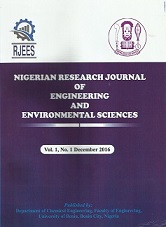Non-Random-Two-Liquid Thermodynamic Model for Ethanol Production from Cassava Waste Slurry using a Computer-Aided Aspen HYSYS Simulation
Authors: *Ugwuodo C. B., Itiri H.U., Ekeoma, N., Emmanuel, I.N., Agbokwor, S. E., Sunday, N.B. And Oyedoh, E.A.
DOI Info: http://doi.org/10.5281/zenodo.15778142
ABSTRACT
Bioethanol is a clean and renewable fuel that is produced from renewable resources. Cassava waste slurry is an agricultural and renewable residue rich in cellulose but is not part of the food chain. It is also a renewable substrate for ethanol production. In this research work, we seek to model, simulate, and study the process of ethanol production using ASPEN HYSYS. The simulation of ethanol production begins with the introduction of a combined stream of 200 kg/h of waste cassava slurry, 100 kg/h of water, and 20 kg/h of H2SO4 at a temperature of 25 oC, and the reactor temperature of 80 oC under atmospheric pressure. Thus, the distilled product stream with a total molar flow of 3.964 kmol/h had a composition of 99.22% mol of ethanol, 0.76% mol of water, and 0.02% mol of carbon dioxide. The bottom stream, with a total molar flow of 0.2 kmol/h, had a composition of 1.9% mol of water with traces of H2SO4. Thus, this suggests that the modeled process plant could produce 492.3 m3/h high-quality bioethanol from 588.2 m3/h waste cassava slurry based on the conditions adopted for the study.
Affiliations: Department of Chemical Engineering, College of Engineering and Engineering Technology, Michael Okpara University of Agriculture, Umudike, Nigeria.
Keywords: Aspen Hysys, Bio-ethanol, Cellulose, Process Simulation, Waste Cassava Slurry
Published date: 2025/06/30









